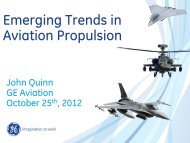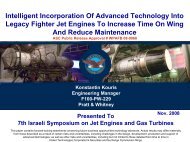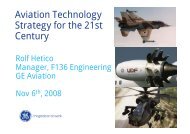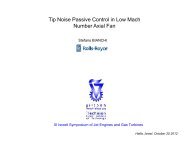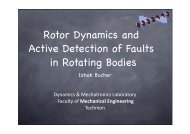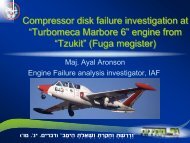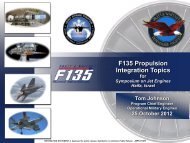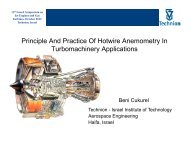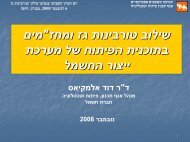8. Atomization vs. Vaporization of Fuel in Micro Gas Turbines
8. Atomization vs. Vaporization of Fuel in Micro Gas Turbines
8. Atomization vs. Vaporization of Fuel in Micro Gas Turbines
- No tags were found...
You also want an ePaper? Increase the reach of your titles
YUMPU automatically turns print PDFs into web optimized ePapers that Google loves.
<strong>Atomization</strong> <strong>vs</strong>. <strong>Vaporization</strong><strong>of</strong> <strong>Fuel</strong> <strong>in</strong> <strong>Micro</strong> <strong>Gas</strong> Turb<strong>in</strong>esDaniel Kutikov and Pr<strong>of</strong>. Yeshayahou LevyFaculty <strong>of</strong> Aerospace Eng.Technion, Haifa
Impact <strong>of</strong> fuel delivery system<strong>Atomization</strong><strong>Fuel</strong> distributionEvaporationMix<strong>in</strong>gIgnitionFlame stabilityCombustion efficiencyDifficulties <strong>in</strong> small-scale jet eng<strong>in</strong>e: Low ignition energy Small combustor volume Simplicity <strong>of</strong> the atomizer/vaporizer2/20
Exist<strong>in</strong>g models for combustion <strong>of</strong>liquid fuel• Semi-empirical droplet siz<strong>in</strong>g models for a s<strong>in</strong>gleatomizer• Evaporation models for droplets Need for <strong>in</strong>tegration <strong>of</strong> processes and models• CFD <strong>in</strong>volv<strong>in</strong>g two-phase flow and evaporation,combustion chemistry, heat transfer Heavy numerical calculations3/20
Research method (cont.)Measurements:• Air & fuel flows• Combustor outlet temperature at 4 po<strong>in</strong>ts• Combustion gas concentrations at 4 po<strong>in</strong>tsEvaluations:• Stable operational envelope• Combustion Efficiency• Chemical efficiency6/20
Research method (cont.)Combustion efficiencies – def<strong>in</strong>itions:Enthalpy rise through combustorCombustion Efficiency, η(T) =Chemical energy <strong>of</strong> liquid fuelChemical efficiency, η(Ch) = 1 -Chemical energy <strong>of</strong> fuel rema<strong>in</strong> <strong>in</strong> exhaust gasesChemical energy <strong>of</strong> vaporized liquid fuelUHC CH47/20
Experiment setupAir compressor<strong>Gas</strong> analyzerCO2, CO, UHC,O2, NOX8/20
Experiment setup (cont.)<strong>Gas</strong> analyzer:CO2, CO, UHC, NOX, O29/20
Experiment setup (cont.)Combustor setup:10/20
Experiment setup (cont.)Blocked combustorNozzle r<strong>in</strong>gOpen combustor11/20
Experiment setup (cont.)12/20
ResultsExit temperature for different air and fuel mass flow ratesT04 =QRf + CP<strong>in</strong>T03CPg(1 + f)°Cη bf13/20
Results (cont.):combustion efficiencies η(T) for different configurationsηTfCurrentcompressor limitf14/20
Low efficiency:• low <strong>in</strong>let temperature• low air pressure Incomplete vaporization Insufficient residence time Insufficient mix<strong>in</strong>gResults (cont.)η = F(tR)Too high O2Too low CO215/20
Results (cont.)ηbDifferences ma<strong>in</strong>ly due tounvaporized liquid fuel16/20
Low equivalence ratio:almost completecombustionHigh equivalence ratio:<strong>in</strong>complete combustion17/20
ConclusionsAtomizers Wider stable operational range(wider fuel supply ranges: 3 – 6g/sec <strong>vs</strong>. 0.5 – 2g/sec) Higher fuel flow rates & temperatures at the max efficiency po<strong>in</strong>ts(4g/sec <strong>vs</strong>. 1g/sec & 1300K <strong>vs</strong>. 800K) Simple ignition (electric plug) Faster transient responseX Larger combustor volume required (for evaporation & mix<strong>in</strong>g)X Higher fuel pressure requirementVaporizers Higher efficiency due to longer vaporized fuel flow path(η=0.9 <strong>vs</strong>. 0.75) (higher combustion pressure would give higher efficiencies)X Complicated ignition (additional gas ignition system required)X Slower transient response (thermal <strong>in</strong>ertia & fuel evaporation time)18/20
GeneralConclusions (Cont.)• Combustion efficiency <strong>in</strong>creases with pressure• Unvaporized fuel affect efficiency values, henceshould be accounted for (η(Ch) <strong>vs</strong>. η(T))• Direct retr<strong>of</strong>itt<strong>in</strong>g <strong>of</strong> atomizers <strong>in</strong>stead <strong>of</strong> vaporizeswiden operational envelope but reducescombustion efficiencies• New designs that can account for the larger volumerequired by atomizer may benefit from itsadvantages19/20
Questions?20/20
21/20
Experiment setup (cont.)Compensation <strong>of</strong> the radiative heat losses from TC:The model was validated by comparison<strong>of</strong> shielded and unshielded thermocouples22/20
Results (cont.)Low efficiency: high UHC valuesf23/20



